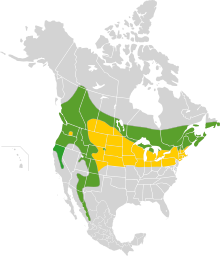Evening grosbeak
| Evening grosbeak | |
|---|---|
 |
|
| Male evening grosbeak in Cap Tourmente National Wildlife Area, Quebec | |
| Scientific classification | |
| Kingdom: | Animalia |
| Phylum: | Chordata |
| Class: | Aves |
| Order: | Passeriformes |
| Family: | Fringillidae |
| Subfamily: | Carduelinae |
| Genus: | Coccothraustes |
| Species: | C. vespertinaus |
| Binomial name | |
|
Coccothraustes vespertinus (W. Cooper, 1825) |
|
 |
|
| Range of C. vespertinus Year-round range Wintering range | |
| Synonyms | |
|
Hesperiphona vespertina |
|
Hesperiphona vespertina
The evening grosbeak (Coccothraustes vespertinus) is a passerine bird in the finch family Fringillidae found in North America.
The International Ornithologists' Union and the Handbook of the Birds of the World place the evening grosbeak in the genus Hesperiphona. However, the species is named Coccothraustes vespertinus (in the same genus as the hooded grosbeak and the hawfinch) by the Clements Checklist and the American Ornithologists' Union.
The genus Hesperiphona was introduced by Charles Lucien Bonaparte in 1850. The name is from Ancient Greek hesperos, "evening", and phone "cry", and the specific vespertina is Latin for "evening".
The evening grosbeak is similar in appearance to the Eurasian hawfinch, both being bulky, heavily built finches with large bills and short tails. The evening grosbeak ranges in length from 16 to 22 cm (6.3 to 8.7 in) and spans 30 to 36 cm (12 to 14 in) across the wings. In a large sampling of grosbeaks in Pennsylvania during winter, males weighed from 38.7 to 86.1 g (1.37 to 3.04 oz), with an average of 60 g (2.1 oz), while females weighed from 43.2 to 73.5 g (1.52 to 2.59 oz), with an average of 58.7 g (2.07 oz). Among standard measurements, the wing chord is 10.45 to 11.6 cm (4.11 to 4.57 in), the tail is 6 to 6.95 cm (2.36 to 2.74 in), the bill is 1.6 to 2 cm (0.63 to 0.79 in) and the tarsus is 1.95 to 2.2 cm (0.77 to 0.87 in). The adult has a short black tail, black wings and a large pale bill. The adult male has a bright yellow forehead and body; its head is brown and there is a large white patch in the wing. The adult female is mainly olive-brown, greyer on the underparts and with white patches in the wings.
...
Wikipedia

